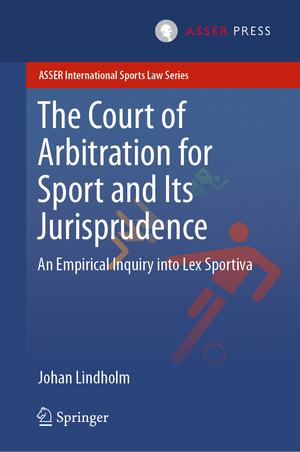The Court of Arbitration for Sport and Its Jurisprudence: An Empirical Inquiry into Lex Sportiva: ASSER International Sports Law Series
Autor Johan Lindholmen Limba Engleză Hardback – 2 apr 2019
It also investigates the actors involved in adjudication before the CAS, both the parties that bring disputes before the CAS and the arbitrators that resolve them, and in so doing establish precedents that govern sports generally.
While the book relies upon and includes more traditional legal theory and analysis, it combines this with an empirical analysis of a large portion of the CAS's decisions. Hereby it relies upon and relates to the theory of the development of a transnational legal order in sports, the lex sportiva. The publication is targeted at and will benefit those professionally working in or interested in the fields of sports law, arbitration law, transnational law, or empirical legal studies.
Johan Lindholm is a Professor of Law at Umeå University in Sweden.
Din seria ASSER International Sports Law Series
-
 Preț: 352.17 lei
Preț: 352.17 lei - 18%
 Preț: 1258.91 lei
Preț: 1258.91 lei - 15%
 Preț: 696.50 lei
Preț: 696.50 lei - 18%
 Preț: 792.51 lei
Preț: 792.51 lei - 18%
 Preț: 1005.92 lei
Preț: 1005.92 lei - 23%
 Preț: 615.59 lei
Preț: 615.59 lei - 18%
 Preț: 950.52 lei
Preț: 950.52 lei - 18%
 Preț: 1223.07 lei
Preț: 1223.07 lei - 18%
 Preț: 956.18 lei
Preț: 956.18 lei -
 Preț: 402.76 lei
Preț: 402.76 lei - 18%
 Preț: 1116.57 lei
Preț: 1116.57 lei - 18%
 Preț: 1249.31 lei
Preț: 1249.31 lei - 15%
 Preț: 641.38 lei
Preț: 641.38 lei - 18%
 Preț: 1003.70 lei
Preț: 1003.70 lei - 15%
 Preț: 671.14 lei
Preț: 671.14 lei - 18%
 Preț: 1007.35 lei
Preț: 1007.35 lei - 18%
 Preț: 889.43 lei
Preț: 889.43 lei - 15%
 Preț: 644.95 lei
Preț: 644.95 lei - 18%
 Preț: 970.24 lei
Preț: 970.24 lei - 15%
 Preț: 657.08 lei
Preț: 657.08 lei - 18%
 Preț: 970.24 lei
Preț: 970.24 lei - 18%
 Preț: 1129.65 lei
Preț: 1129.65 lei - 18%
 Preț: 1581.89 lei
Preț: 1581.89 lei - 15%
 Preț: 681.92 lei
Preț: 681.92 lei - 15%
 Preț: 655.13 lei
Preț: 655.13 lei - 18%
 Preț: 1403.22 lei
Preț: 1403.22 lei
Preț: 816.92 lei
Preț vechi: 1021.16 lei
-20% Nou
Puncte Express: 1225
Preț estimativ în valută:
156.37€ • 169.91$ • 131.43£
156.37€ • 169.91$ • 131.43£
Carte disponibilă
Livrare economică 31 martie-14 aprilie
Livrare express 15-21 martie pentru 38.27 lei
Preluare comenzi: 021 569.72.76
Specificații
ISBN-13: 9789462652842
ISBN-10: 9462652848
Pagini: 290
Ilustrații: XIV, 348 p. 60 illus., 39 illus. in color.
Dimensiuni: 155 x 235 x 28 mm
Greutate: 0.69 kg
Ediția:1st ed. 2019
Editura: T.M.C. Asser Press
Colecția T.M.C. Asser Press
Seria ASSER International Sports Law Series
Locul publicării:The Hague, Germany
ISBN-10: 9462652848
Pagini: 290
Ilustrații: XIV, 348 p. 60 illus., 39 illus. in color.
Dimensiuni: 155 x 235 x 28 mm
Greutate: 0.69 kg
Ediția:1st ed. 2019
Editura: T.M.C. Asser Press
Colecția T.M.C. Asser Press
Seria ASSER International Sports Law Series
Locul publicării:The Hague, Germany
Cuprins
Part I. Introduction.- Chapter 1. Cour Suprême Du Sport Mondial.- Chapter 2. Cas: An Overview.- Part II. The Jurisprudence.- Chapter 3. The Lay of the Land: The Topography of Cas’s Jurisprudence.- Chapter 4. Cas Decisions As Precedent.- Chapter 5. Cas’s Landmark Decisions.- Chapter 6. Structure of Cas’s Jurisprudence.- Chapter 7. Cas’s Normative Contribution.- Part III. The Actors.- Chapter 8. Cas Arbitrators and Their Relationships.- Chapter 9. The Characteristics of Cas Arbitrators.- Chapter 10. Cas from the Litigants’ Perspective. Table of Sources.- Table of Cases.- Index.
Recenzii
“In this intellectual, erudite work, Lindholm, relying on a network analysis, proves that in large part CAS retains the characteristics of the oldest network in sport – the old boys’ club, and an old Swiss boys’ club at that.” (Jack Anderson, idrottsforum.org, September 25, 2019)
Notă biografică
Textul de pe ultima copertă
This book takes a close look at the Court of Arbitration for Sport (CAS), challenging existing claims and answering previously unanswered questions, by considering all of its publicly available decisions, both in its entirety as a body of jurisprudence and on a case-by-case level.
It also investigates the actors involved in adjudication before the CAS, both the parties that bring disputes before the CAS and the arbitrators that resolve them, and in so doing establish precedents that govern sports generally.
The publication is targeted at and will benefit those professionally working in or interested in the fields of sports law, arbitration law, transnational law, or empirical legal studies.
Johan Lindholm is a Professor of Law at Umeå University in Sweden.
Caracteristici
Offers an unrivalled insight into all aspects of the CAS and the case law related thereto Investigates the actors involved in adjudication before the CAS The quantitative empirical approach undertaken is completely unique
